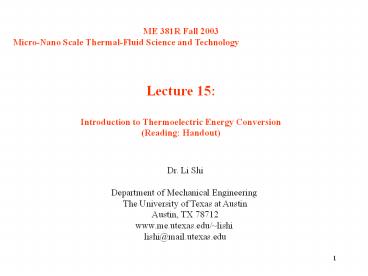ME 381R Fall 2003 - PowerPoint PPT Presentation
1 / 17
Title:
ME 381R Fall 2003
Description:
Thermally-Controlled Car Seat. Electronic Cooling. Cryogenic IR Night Vision. 5 ... To efficiently recover waste heat from car, ZT = 2 is needed. 16. Progress in ZT ... – PowerPoint PPT presentation
Number of Views:34
Avg rating:3.0/5.0
Title: ME 381R Fall 2003
1
ME 381R Fall 2003 Micro-Nano Scale Thermal-Fluid
Science and Technology Lecture
15 Introduction to Thermoelectric Energy
Conversion (Reading Handout)
Dr. Li Shi Department of Mechanical Engineering
The University of Texas at Austin Austin, TX
78712 www.me.utexas.edu/lishi lishi_at_mail.utexas.
edu
2
References
Thermo-electrics Basic principles and New
Materials Development by Nolas, Sharp and
Goldsmid Thermoelectric Refrigeration by
Goldsmid Thermodynamics by Callen. Sections 17-1
to 17-5
3
Outline
- Thermoelectric Effects
- Thermoelectric Refrigeration
- Figure of Merit (Z)
- Direct Thermal to Electric Power Generation
4
Applications
Cryogenic IR Night Vision
Beer Cooler
Thermally-Controlled Car Seat
Electronic Cooling
5
Basic Thermoelectric Effects
- Seebeck effect
- Peltier Effect
- Thomson effect
6
Seebeck Effect
- In 1821, Thomas Seebeck found that an electric
current would flow continuously in a closed
circuit made up of two dissimilar metals, if the
junctions of the metals were maintained at two
different temperatures.
S dV / dT S is the Seebeck Coefficient with
units of Volts per Kelvin S is positive when the
direction of electric current is same as the
direction of thermal current
7
Peltier Effect
- In 1834, a French watchmaker and part time
physicist, Jean Peltier found that an electrical
current would produce a temperature gradient at
the junction of two dissimilar metals.
? lt0 Negative Peltier coefficient High energy
electrons move from right to left. Thermal
current and electric current flow in opposite
directions.
8
Peltier Cooling
? gt0 Positive Peltier coefficient High energy
holes move from left to right. Thermal current
and electric current flow in same direction.
q?j, where q is thermal current density and j
is electrical current density. ? ST (Volts)
T is the
Absolute Temperature
9
Thomson Effect
- Discovered by William Thomson (Lord Kelvin)
- When an electric current flows through a
conductor, the ends of which are maintained at
different temperatures, heat is evolved at a rate
approximately proportional to the product of the
current and the temperature gradient.
is the Thomson coefficient in Volts/Kelvin
Seebeck coeff. S is temperature dependent
Relation given by Kelvin
10
Thermoelectric Refrigeration
The rate of heat flow from one of the legs (i1
or 2)
(1)
11
The rate of heat generation per unit length due
to Joule heating is given by
(2)
Eqn 2 is solved using the boundary conditions T
Tc at x0 and T Th at x l. Thus it is found
that
(3)
The total heat removed from source will be sum of
q1 and q2
qc (q1 q2 )x0
(4)
Eqs. 1, 3, 4?
K Thermal conductance of the two legs R
Electrical Resistance of the two legs
12
The electrical power is given by
COP is given by heat removed per unit power
consumed
Differentiating w.r. to I we get max. value of COP
where
and Tm(ThTc)/2
A similar approach can be used to obtain the
maximum degree of cooling and maximum cooling
power.
13
It is obvious that z will be maximum when RK will
have minimum value. This occurs when
When this condition is satisfied z becomes
Further, if S2-S1 S, k1 k2 K, s1 s2 s
14
ZTm vs. COP
15
Criteria
- For greatest cooling efficiency we need a
material that - conducts electricity well (like metal)
- conducts heat poorly (like glass)
- Bismuth telluride is the best bulk TE material
with ZT1 - To match a refrigerator, ZT 4 - 5 is needed
- To efficiently recover waste heat from car, ZT
2 is needed
16
Progress in ZT
Fundamental limitations k and s, S and s are
coupled.
17
Thermoelectric Power Generation
- Used in Space shuttles and rockets for compact
source of power. - Diffusive heat flow and Peltier effect are
additive i.e. both reduce the temperature
gradient. - The efficiency of power generation is given by
where w is the power delivered to the external
load QH is the positive heat flow from
source to sink































